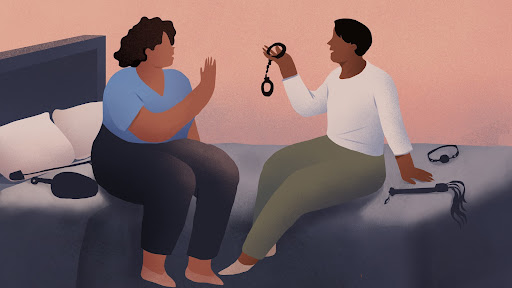
Examining BDSM Representations in Popular Media
Although 50 Shades of Grey, a popular and controversial series, caused conversations about kinks and BDSM in mainstream culture, BDSM existed long before its famous and problematic representation. BDSM is a huge umbrella term that refers to a variety of practices, including the use of slavery, dominion, role-playing, humiliation and other non-sexual lifestyle practices. While the way in which participants choose to express their BDSM/kink practices varies from person to person, what remains constant is to respect all parties, including their interests, desires, boundaries and to allow each person to make decisions and ultimately to agree with all involved parties.
The popular series “50 Shades” seems to encourage more open discussion or consideration of BDSM/kink dynamics, but many point out that the relationships between the main characters Anastasia and Christian Grey do not represent a consensus kink with agreed limits and limits. Furthermore, they are not a form of evil manipulation, coercion and ultimately derogatory abuse, like it was shown. Therefore, the fictional couple does not accurately represent the experiences of a consensus couple involved in kink. However, “50 Shades of Gray” franchises are not the only problematic images of BDSM dynamics on screens. Most of the media’s BDSM/kink representation does not properly explain what BDSM is and how to practice it safely.
“365 Days”, a Polish erotic film released in 2020, quickly gained popularity among viewers with shocking sex scenes, but despite its one-hour and 54-minute run time, no scenes included open communication about sexual desires or needs, trust and mutual respect, the use of agreed safe words by consenting parties, or aftercare after sexual encounters. But it’s not all bad representation available in the media because of movies like “Love and Leashes”, a Korean Netflix movie adapted from a webtoon with the name “Moral Sense/The sensual M”, released in 2022 which is good to watch for its sensual, light and educational BDSM representation. It not only concentrated on the idea that everyone has a right to their own preferences and that everyone has boundaries that should be respected but also explained the meaning of various terms like SSC, D/S, S/M. The movie talked about various fetishes like wax play, trampling, humiliation play, pet play, shibari, etc. It also didn’t shy away from showing the real problems people in the BDSM community face with creepy abusers trying to infiltrate and intolerant, conservative people discriminating against sexual freedom.

Why does the Media need more Positive BDSM Portrayal?
Why does it matter if a movie or book doesn’t have realistic or encouraging depictions, one could wonder. Although it may appear petty or irrelevant, it is crucial to pause and analyse what the media is really saying to us about our life, our sexuality, the ways in which we display our sexuality, and whether these messages are positive or negative in a world that is overflowing with information. The issue is not with fantasies. The issue emerges when we take fictional worlds for real and watch media like “50 Shades of Grey” without understanding that the cornerstone of safe, consensual BDSM is respect for other people’s privacy, interests, anxieties, and boundaries. We also have blogs on the basics of kink and fetishes and the boundaries that people participating need to keep in mind which you can read if you are interested in learning more about this.
The media needs to start thinking about the significance of its representations of kink/BDSM and then work diligently to include more accurate representations in order to best underline this point and express what the beneficial foundations of a healthy BDSM lifestyle/relationship are. Providing more nuanced, realistic, and positive representations can serve to curtail the spread of myths about the BDSM community, enlighten people who have been misinformed, and even assist others who are just getting started with kink and want to gain a deeper knowledge. Those who are interested in consensual BDSM practices may experience stigmatisation, exclusion, and feelings of shame as a result of inaccurate or unfavourable depictions of BDSM and, consequently, of those who engage in it. Many frequently believe that BDSM must be intrinsically “evil” and/or that the main trait of all kinks is the nonconsensual manipulation of an intimate partner as a result of negative representations of BDSM.

Conclusion
BDSM is frequently misrepresented as a deviant social practice that focuses solely on the unwilling subjugation, exploitation, control, and abuse of others. The truth is far from this extremely negative and dangerous portrayal. Kink/BDSM is secure, rational, and consensual. As a result, practitioners of safe, sane, and consensual BDSM acknowledge that consent is a continuous process that can be revoked at any time. Consent obtained once, twice, three times, or even four times does not guarantee consent in the future. The relationship is fluid, and power play (if and when it is used between consenting parties) does not imply abuse or manipulation of another being. Everyone is free to make decisions that are best for them and they should!
Many films overlook the development of boundaries, limitations, agreed-upon terms, mutual respect, active listening, the use of a safe word, and aftercare immediately following the conclusion of a sexual scene in their depiction of kink or BDSM. Sexual shame can be avoided by including representations of BDSM in the media that take the time to depict mutual trust and respect of all parties within the context of safe, sane, and consensual dynamics. Instead, more positive messages about sexuality should be shared.
Author

